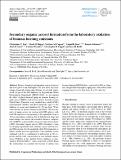| dc.contributor.author | Lim, Christopher Yung-Ta | |
| dc.contributor.author | Hagan, David Henry | |
| dc.contributor.author | Coggon, Matthew M. | |
| dc.contributor.author | Koss, Abigail R. | |
| dc.contributor.author | Sekimoto, Kanako | |
| dc.contributor.author | de Gouw, Joost | |
| dc.contributor.author | Warneke, Carsten | |
| dc.contributor.author | Cappa, Christopher D. | |
| dc.contributor.author | Kroll, Jesse | |
| dc.date.accessioned | 2020-06-17T13:59:07Z | |
| dc.date.available | 2020-06-17T13:59:07Z | |
| dc.date.issued | 2019-10 | |
| dc.date.submitted | 2019-04 | |
| dc.identifier.issn | 1680-7324 | |
| dc.identifier.uri | https://hdl.handle.net/1721.1/125831 | |
| dc.description.abstract | Biomass burning is an important source of aerosol and trace gases to the atmosphere, but how these emissions change chemically during their lifetimes is not fully understood. As part of the Fire Influence on Regional and Global Environments Experiment (FIREX 2016), we investigated the effect of photochemical aging on biomass burning organic aerosol (BBOA) with a focus on fuels from the western United States. Emissions were sampled into a small (150 L) environmental chamber and photochemically aged via the addition of ozone and irradiation by 254 nm light. While some fraction of species undergoes photolysis, the vast majority of aging occurs via reaction with OH radicals, with total OH exposures corresponding to the equivalent of up to 10 d of atmospheric oxidation. For all fuels burned, large and rapid changes are seen in the ensemble chemical composition of BBOA, as measured by an aerosol mass spectrometer (AMS). Secondary organic aerosol (SOA) formation is seen for all aging experiments and continues to grow with increasing OH exposure, but the magnitude of the SOA formation is highly variable between experiments. This variability can be explained well by a combination of differences in OH exposure and the total concentration of non-methane organic gases (NMOGs) in the chamber before oxidation, as measured by PTR-ToF-MS (r2 values from 0.64 to 0.83). From this relationship, we calculate the fraction of carbon from biomass burning NMOGs that is converted to SOA as a function of equivalent atmospheric aging time, with carbon yields ranging from 24±4% after 6 h to 56±9% after 4 d. ©Author(s) 2019. | en_US |
| dc.description.sponsorship | NOAA AC4 program (grant no. NA16OAR4310112) | en_US |
| dc.description.sponsorship | NOAA AC4 program (grant no. NA16OAR4310111) | en_US |
| dc.description.sponsorship | NSF graduate research fellowship program | en_US |
| dc.language.iso | en | |
| dc.publisher | Copernicus GmbH | en_US |
| dc.relation.isversionof | https://dx.doi.org/10.5194/ACP-19-12797-2019 | en_US |
| dc.rights | Creative Commons Attribution 4.0 International license | en_US |
| dc.rights.uri | https://creativecommons.org/licenses/by/4.0/ | en_US |
| dc.source | Copernicus Publications | en_US |
| dc.title | Secondary organic aerosol formation from the laboratory oxidation of biomass burning emissions | en_US |
| dc.type | Article | en_US |
| dc.identifier.citation | Lim, Christopher Y. et al., "Secondary organic aerosol formation from the laboratory oxidation of biomass burning emissions." Atmospheric Chemistry and Physics 19, 19 (October 2019): p. 12797–12809 doi. 10.5194/acp-19-12797-2019 ©2019 Authors | en_US |
| dc.contributor.department | Massachusetts Institute of Technology. Department of Civil and Environmental Engineering | en_US |
| dc.relation.journal | Atmospheric Chemistry and Physics | en_US |
| dc.eprint.version | Final published version | en_US |
| dc.type.uri | http://purl.org/eprint/type/JournalArticle | en_US |
| eprint.status | http://purl.org/eprint/status/PeerReviewed | en_US |
| dc.date.updated | 2020-05-28T17:25:21Z | |
| dspace.date.submission | 2020-05-28T17:25:23Z | |
| mit.journal.volume | 19 | en_US |
| mit.journal.issue | 19 | en_US |
| mit.license | PUBLISHER_CC | |
| mit.metadata.status | Complete | |
